Sticker shock! How to position portfolios for a potential inflation breakout
Along with rising commodity prices over recent months, the recent much higher than expected lift in United States consumer prices has heightened global market concern over a potential breakout in inflation. For those investors concerned about such a risk, this note considers some potential ways they can add an ‘inflation hedge’ to their portfolios.
Post-COVID inflation shock
No sooner had global investors stopped worrying about the downside risks to economic growth due to the COVID crisis than another concern has emerged – rising inflation.
To an extent, such concerns are not unwarranted.
After all, the global economy is enjoying a V-shaped recovery, with the policy focus now on driving down still high rates of unemployment to levels that could start to generate a sustained lift in wage and price inflation.
Consumer spending has also lifted at a time when production and transport capacity in many economies is still recovering from the shutdowns, and many workers – for various reasons – are holding back from seeking out new jobs. The result has been labour and product shortages and some pressure on wages and prices – far earlier than policy makers generally anticipated. Energy, food and metal prices have already lifted strongly which has resulted in steep gains in wholesale prices.
These inflation concerns have recently come to a head, with a far higher than expected lift in U.S. consumer prices during April. Indeed, even excluding volatile items such as food and energy, the so-called ‘core’ U.S. CPI Index rose 0.9% in the month which, along with very low price increases during the shutdowns this time last year, meant the annual core CPI rate lifted to 3% – the highest since the mid-1990s!
Debate now rages on whether the lift in price pressure is the start of a sustained increase in global inflation, or merely the lingering effect of COVID-related mismatches between supply and demand. Either way, with global policy makers likely to continue to encourage strong economic growth for some time, it’s quite possible that many commodity and consumer prices may enjoy stronger gains over the next few years than evident prior to COVID.
Outlined below are several investment exposures that may stand to benefit – each in their own way – from stronger pricing pressure.
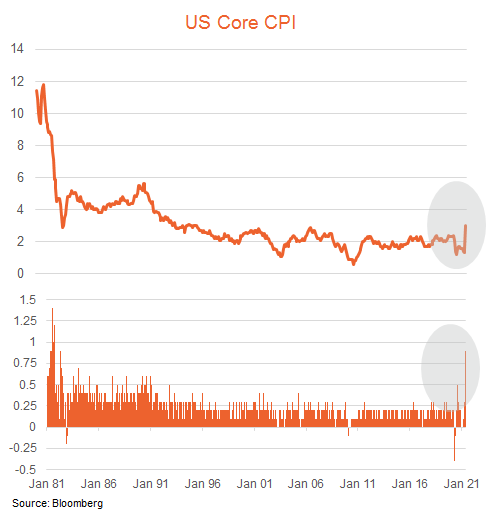
Food producers (FOOD ETF)
Global food prices have lifted strongly in recent months, reflecting solid demand (especially with more people eating at home during the pandemic), along with supply bottlenecks and also poor growing conditions in major countries such as the United States.
As seen in the chart below, the relative share price performance of the world’s top food producers (excluding Australia, and as captured by the Index which the FOOD ETF aims to track), has tended to be positively correlated with food price trends. Indeed, the FOOD ETF has delivered relatively strong gains since the bottoming in global equity prices early last year, and further relatively strong gains seem possible if food prices continue to rise.
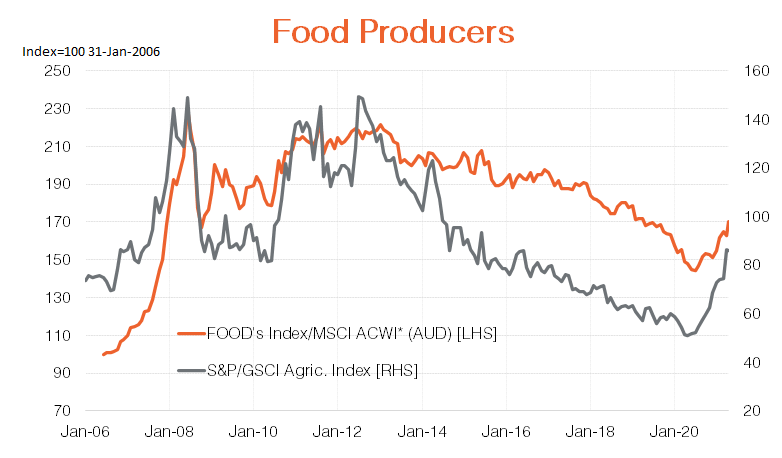
Source: BetaShares, Bloomberg. *Ratio of total return indices in AUD. Past performance is not indicative of future performance of any index or ETF. Index performance does not take into account ETF fees and costs. You cannot invest directly in an index.
Energy producers (FUEL ETF)
Similar to the FOOD ETF above, the FUEL ETF provides exposure to the top energy producers (ex Australia) around the world. As evident in the chart below, the relative performance of FUEL compared to global markets has tended to be positively correlated with trends in global oil prices. As might therefore be expected, the sharp lift in oil prices since their COVID lows early last year has been associated with relatively strong performance by FUEL since late-2020. Should oil prices continue to rise due to recovering global demand, FUEL may be well positioned to continue to outperform.
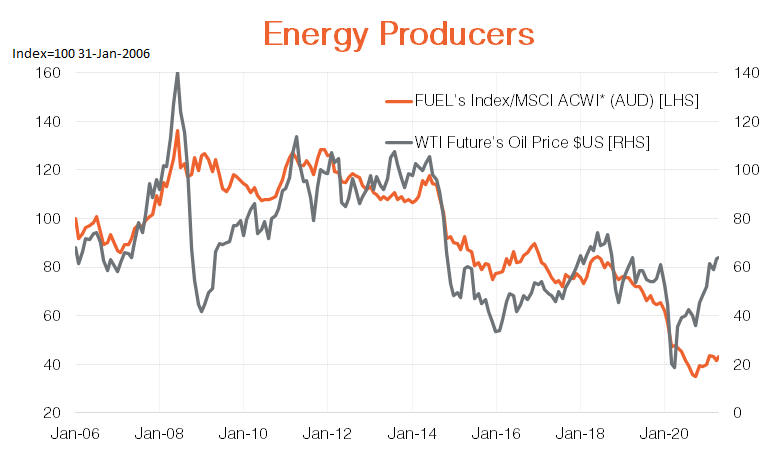
Source: BetaShares, Bloomberg. *Ratio of total return indices in AUD. Past performance is not indicative of future performance of any index or ETF. Index performance does not take into account ETF fees and costs. You cannot invest directly in an index.
Gold producers (MNRS ETF)
Gold is another commodity which history suggests tends to benefit from a rising inflationary environment.
As evident in the chart below, gold has experienced several price cycles over recent years, which in turn have tended to be positively correlated with the relative share price performance of the world’s top gold mining companies (excluding Australia) as measured by the Index which the MNRS ETF aims to track. Indeed, gold recently enjoyed solid price gains in the two years from late-2018 to late-2020, a period in which the MNRS ETF also performed relatively strongly. Although both gold and MNRS have pull backed in recent months, both may be well placed to benefit should global inflationary pressures intensify.
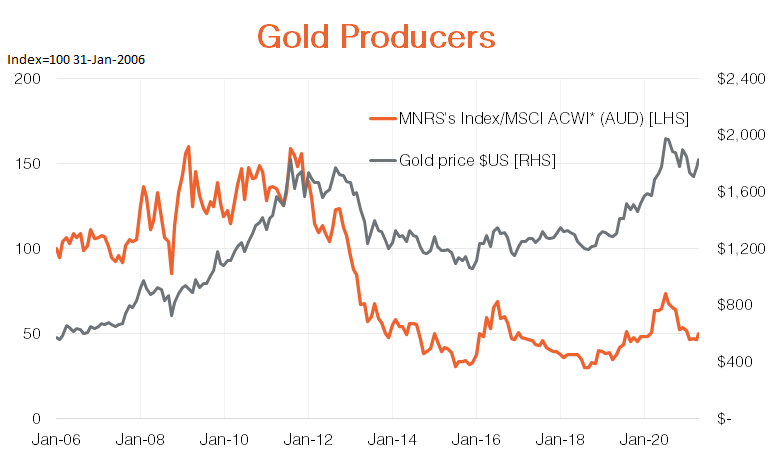
Source: BetaShares, Bloomberg. *Ratio of total return indices in AUD. Past performance is not indicative of future performance of any index or ETF. Index performance does not take into account ETF fees and costs. You cannot invest directly in an index.
Australian miners (QRE ETF)
Closer to home, another option that could offer good exposure to a rising inflationary environment – especially through commodities like iron-ore – is Australian mining companies. As seen in the chart below, the relative performance of Australian miners (as represented by the Index which the QRE ETF aims to track) within the local market has tended to be correlated with trends in iron-ore prices. Indeed, relative performance was generally negative with the downtrend in iron-ore prices from 2011 to 2016, but has tended to be positive with the uptrend in iron-ore prices in recent years.
In fact, given the explosive rise in iron-ore prices in the past year – reflecting Chinese policy stimulus and Australian/Brazilian supply constraints – local mining companies have arguably not outperformed by as much as one might have expected from historical relationships. This suggests there may be somewhat more relative upside performance even if iron-ore prices pull back somewhat in coming months, but nonetheless remain at relatively high historic levels.
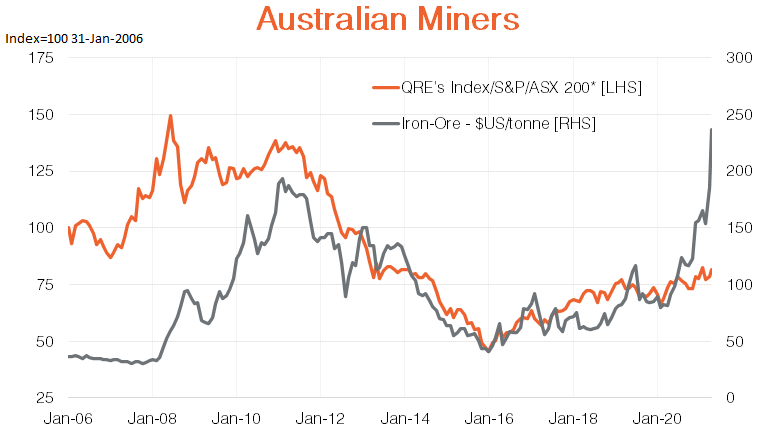
Source: BetaShares, Bloomberg. *Ratio of total return indices in AUD. Past performance is not indicative of future performance of any index or ETF. Index performance does not take into account ETF fees and costs. You cannot invest directly in an index.
Global banks (BNKS ETF)
Although not directly related to trends in inflation, one global equity exposure that may benefit from any associated lift in interest rates is global banks. As seen in the chart below, the relative performance of global banks (as represented by the Index which the BNKS ETF aims to track) has tended to be positively correlated with trends in bond yields.
That’s because a rising bond yield environment have tended to be associated with rising demand, which is positive for credit growth. Higher bond yields have also tended to widen bank interest-rate margins (and hence earnings) as the long-term rates at which they offer credit tends to increase by more than the short-term cost of financing their pool of deposits. Indeed, the upturn in bond yields since mid-2020 has been associated with an upturn in the relative performance of BNKS.
Accordingly, if inflation does lift on a more sustained basis, leading to central banks to bring forward their policy tightening timetable, global bond yields could rise further in the months ahead – which in turn would favour relative outperformance by BNKS. Even if central banks don’t lift rates any time soon, however, the medium-term trend for bond yields is now likely up due to global economic recovery and likely eventual central bank moves to normalise policy rates in the years ahead.
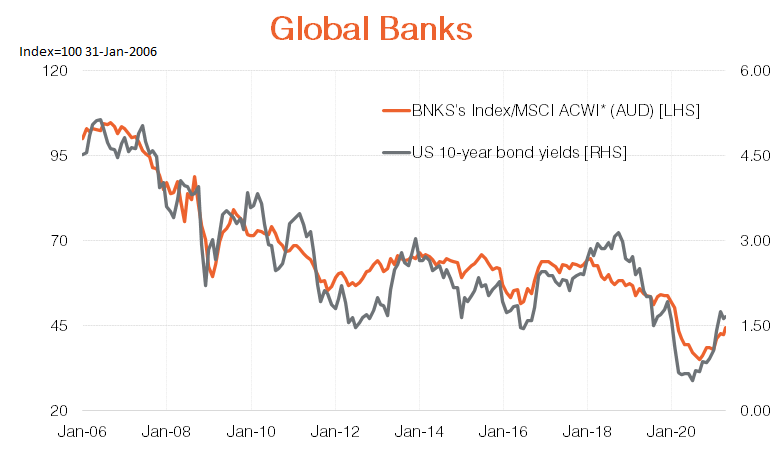
Source: BetaShares, Bloomberg. *Ratio of total return indices in AUD. Past performance is not indicative of future performance of any index or ETF. Index performance does not take into account ETF fees and costs. You cannot invest directly in an index.
All up, for investors concerned about a potential sustained lift in inflation and/or interest rates, BetaShares offers a range of commodity and financial related equity exposures that may offer useful hedges in one’s portfolio.
Australia's 100 top-rated funds
Livewire's Top-Rated Fund Series gives subscribers exclusive access to data and insights that will help them make more informed decisions.
Click here to view the dedicated website, which includes:
- The full list of Australia’s 100 top-rated funds.
- Detailed fund profile pages, with data powered by Morningstar.
- Exclusive interviews with expert researchers from Lonsec, Morningstar and Zenith.
- Videos and articles featuring 16 top-rated fund managers.
3 topics
5 stocks mentioned

